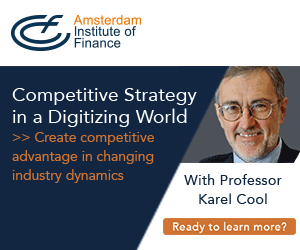Navigating from strategy development to execution is one of the biggest challenges for today’s leaders – few are successful. A recent survey by The Economist found that a discouraging 57 percent of firms failed to efficiently execute strategic initiatives over the past three years.
“There is a serious need for realism when it comes to strategy execution”, says Frans van Loef, who’s an expert on the subject. “Top consultants and Board members challenge organizations to create an extremely ambitious strategy, which is good for setting the direction and getting out of the comfort zone. But how many organizations succeed in executing this strategy? Does your organization meet its strategic goals?”
“When you are participating in the strategy process – with the CEO, colleagues and strategy consultants – there is a psychological process taking place where people start to believe that you can make the strategy happen. It can be very energizing to visualize this future situation. However, as soon as organizations start executing the strategy, they find out that it’s very challenging to ‘just do it’.”
“I’ve been there.” Van Loef has over twenty years of experience in the matter: running strategy execution as CEO of companies himself and lately as Strategy Execution Consultant helping international companies with accelerating strategy execution. He’s an expert on unlocking capacity (time & talent) and last year his book FreeCapacity was published.
“There are two fundamental challenges that I encounter everywhere.”
1. Not enough resources allocated to strategy execution
“For most companies, there are two scarce resources: financial resources and organizational capacity (time & talent of people). Top management looks in depth at the financial resources necessary, but the organizational capacity that is needed is too often ignored – it’s like a blind spot. We just do it next to all the daily work and neglect that key people are usually loaded to their maximum capacity, or even worse, are already overloaded. Companies hardly manage scarce capacity at all and aren’t aware of how much capacity is spent on what areas. Or worse: capacity is just wasted on non-contributing activities.”
Van Loef gives a simple example of a CEO of a large international bank. “The CEO is a very smart man who asked a few questions every week during the Board meeting, and every week people worked on providing answers to those questions. Answers to some questions took only a few hours to prepare, but the majority of the questions took entire teams several days to sort out. The CEO is a very competent man, but if he had known that many of those questions cost € 20,000 or more to answer, he might not have asked them.”
“The good news is that international studies confirm that in many organizations the amount of capacity waste can easily be up to 20% of the total capacity available. What would it mean for your strategy execution if you found a way to unlock this capacity and allocate it to strategic activities?”
2. How to run the daily business while at the same time taking fundamental steps forward by executing the strategy
Frans van Loef continues: “The second challenge is making sharper choices within strategies. Coming up with a strategy is very different from executing it. If a strategy contains four options, all four of them may be excellent, but it might be impossible to achieve excellent results for all four. It might be better to leave one option, perhaps the most complex one, for later. Trying to do it all at the same time leads to tremendous switch cost and lack of focus. As a result people will be even more inclined to stick to the pressing daily matters. Strategy execution requires focus. It cannot all happen at the same time.”
With a very simple tool it is possible to make fast and fundamental choices on what to push forward, what to put on hold (time-out) and what to stop. And this clears the road for a better balance between daily business and key strategic initiatives.
Van Loef: “In a recent project, a healthcare organization was able to eliminate 34% of all running projects or initiatives within six weeks’ time. Imagine what it would mean for your organization and how this could impact the challenge of running a business versus building for the future!”
CFO’s position
The CFO has the perfect role to be a gatekeeper in how an organization uses its scarce resources, not only money but also human capital.
“Many things have to do with adhering to the core idea. Many organizations I have been working with recently are amazing at how they organize and execute the work – scrum for example is being executed really well. But when there are too many activities on your plate, the way of addressing those issues does not guarantee the right allocation of resources. This is a blind spot for most companies.”
“The CFO who addresses this, will be more valuable in the strategy discussions and in allocating scarce money and capacity.”
Frans van Loef will demonstrate how to unlock and manage scarce capacity in the course ‘Competitive Strategy in a Digitizing World’, which he teaches with Professor Karel Cool.
